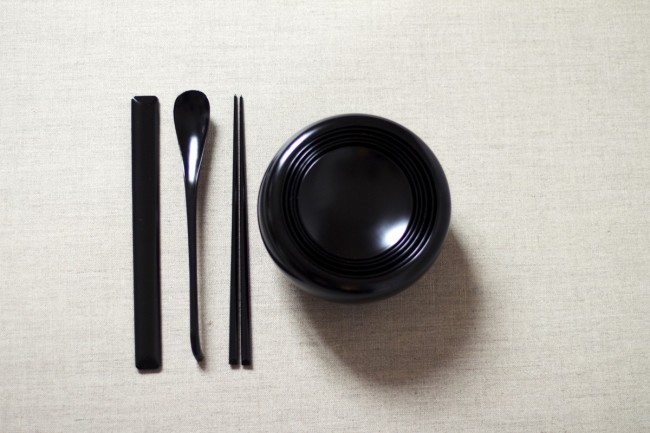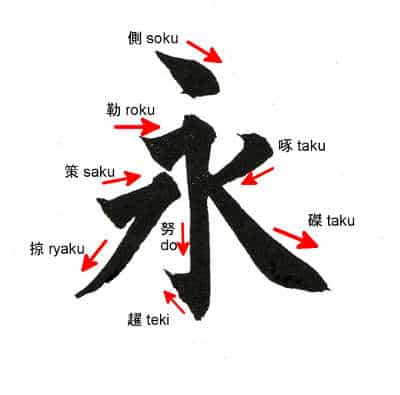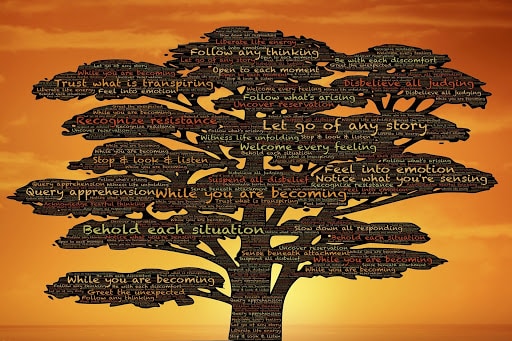In the early centuries of Buddhism in Asia, Zen monks were primarily homeless wanderers, living a mindful, ascetic life, dedicated to maintaining and passing on the teachings. One of their few possessions was an eating bowl used to beg their daily meal from villagers and others who they might meet on the road.
The development of a monastic system of practice during the T’ang dynasty (8th – 9th centuries) included creation of a formal, communal eating style. In place of the single begging bowl, monks used a set of bowls and utensils, kept together in a wrapping cloth, known as oryoki. The Tea Ceremony (Chanoyu) emerged from the full meal of oryoki.
In Japanese, the word Oryoki is comprised of three symbols (Kanji):
O: the receiver’s response to the offering of food
RYO: a measure, or an amount to be received
KI: the bowl.
In Sanskrit, Ōryōki is called pātra: the alms bowl; begging bowl, and its significance is “just enough”.
The term oryoki includes not just the food-carrying vehicle, but the practice and giving of the recipient. In early Buddhist tradition, the usual practice was for monks to obtain their daily food by begging. Begging actually existed before the Buddha’s time, practiced by many religious sects, but the idea took on a larger meaning in Buddhism, where begging became an act of “offering,” an exchange between a layman and a monk.
In Japanese, the term describing this relationship is ogu.
In Japanese, the term describing this relationship is ogu. O is, as above, the receiver, the one who returns merit to the offerer with teaching and guidance.
The second part of the term, GU, is the offering itself: the food and the action of the offerer. Ogu is a reflection of the first paramita, Dana (giving). The layman gives food (gu), the monk gives dharma. There is also another element of practice included in the term – the idea of “no clinging” – each gives to each spontaneously, “giving” and “receiving” being synonymous.
Buddhist tradition recognizes the monk’s robe and bowl as representing two things most necessary to sustain life. With one, we are supported externally (clothes, shelter), with the other, internally (food). In early Buddhism, transmission of the robe and bowl was an important aspect of patriarchal succession. The items were symbolic of Buddha, and by passing them along, the patriarch emphasized Buddha’s uninterrupted existence.
The present day oryoki used by Zen monks consists of the following items:
- Large “Buddha” bowl, having rounded edges. Soup is not eaten from this bowl, as it is not to be touched by the lips.
- Four successively smaller bowls that nest into each other and into the Buddha bowl
- A small stand on which the Buddha bowl rests
- Hattan, or place mat, made from lacquered paper
- A wooden spoon and set of chopsticks
- A bowl cleaning stick (setsu)
- A holder for spoon, chopsticks, and setsu
- A drying cloth
- A napkin
- A wrapping cloth
- A water board (mizuita), used by monks as a kind of lid on their travel bag (kesagori) to keep out rain
Oryoki requires some instruction to learn how to mindfully handle the bowls, cloths, spoon and chopsticks and follow the sequence of the ceremony.
Basic instruction in oryoki is given to new participants and it is gradually learnt through watching and following more experienced practitoners.
The meal with oryoki bowls is a form of Zen practice that emphasizes lack of greed (taking just enough), awareness (meticulous care in opening and using the bowls), and respect (those served and the server bow in mutual respect.)
The serving of the meal is accompanied by an offering of the same meal to the Buddha on the altar, the chanting of the names of Buddha and a chant of gratitude that begins: “Innumerable labors have brought us this food, we should know how it comes to us.”
The oryoki practice it’s the most complex of the Zendo forms, and the one in which a mistake can be dramatic: the occasional setsu hitting the floor, the gomasio jar tilting over, food dropping on the floor.
In oryoki practice the food is served in succession, one item at a time.
Only when everyone has been served all three dishes does the meal begin.
During the meal we reflect on the effort that brought us this food and consider how it comes to us.We reflect on our virtue and practice, and whether we are worthy of this offering. We regard it as essential to keep the mind free from excesses such as greed.We regard this food as good medicine to sustain our life. We receive the food for the sake of enlightenment.
Also, we have to consider why we are eating. “We regard this food as good medicine to sustain our life”, i.e. it’s not entertainment, it’s not pleasure, it’s what we need to continue our lives, as much as possible we should make that just enough.
The food that’s served is simple, hearty and never spicy. Rice or porridge (guen mai) in the first bowl, which we may season with gomasio only. Soup in the second bowl, and something delightful in the third, often fruits or a small salad.
Oryoki is a simple and elegant manner of sharing meals that comes from Japanese Buddhist monasteries. Transforming the mealtime into an opportunity for practice, it helps us to focus on and appreciate the food we are eating and the way that it has come to us.
The formal oryoki may be viewed as a beautiful, intricate ceremony, but “oryoki” can also be done without bowls, by anyone, anywhere! Learning to eat with awareness–the essence of oryoki--is a practice suitable for anyone who wishes to better appreciate and enjoy food, to improve health, to manage weight and nutrition, and to restore balance.
photo credit: Doug Beghtel




